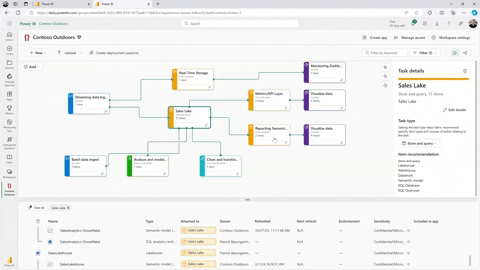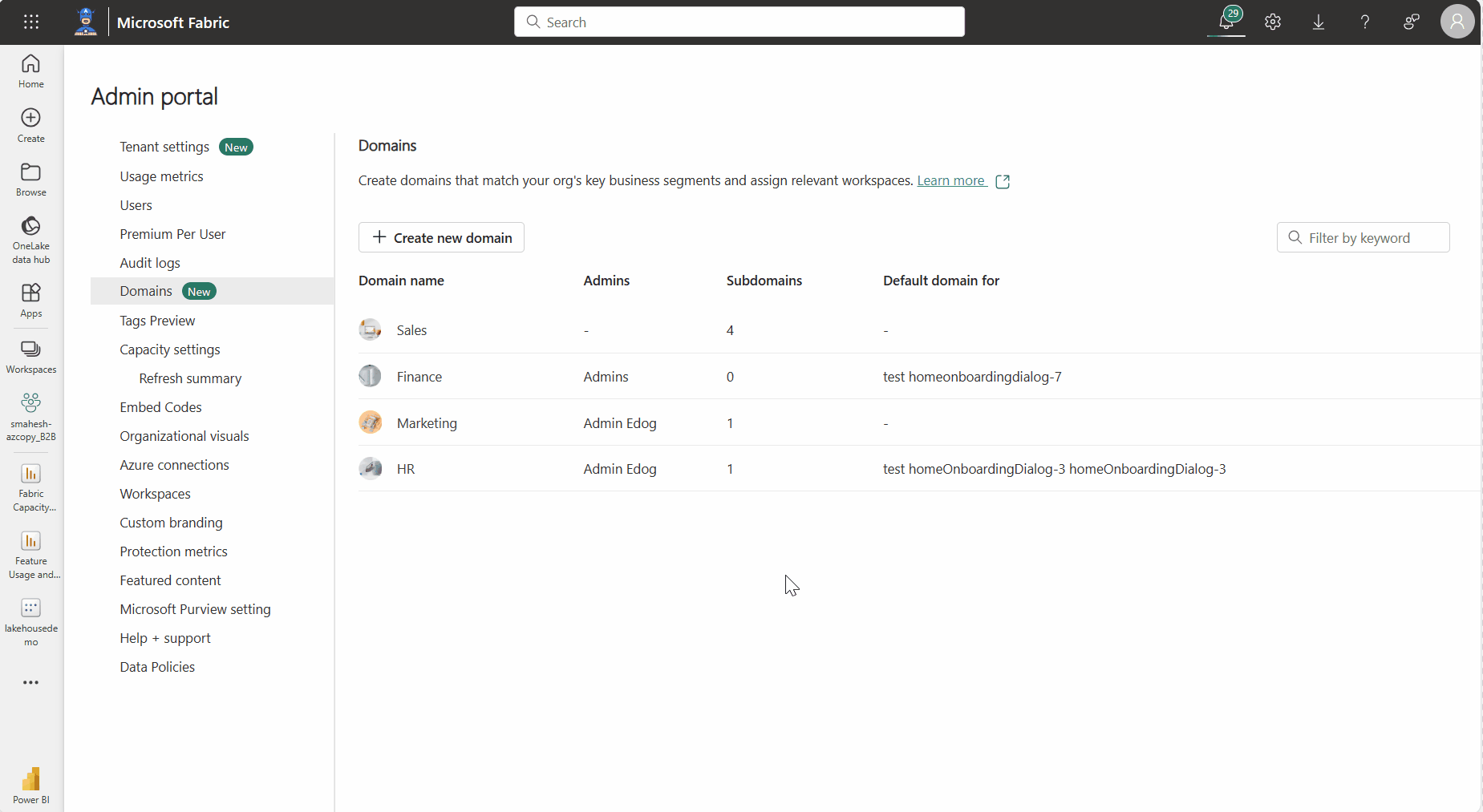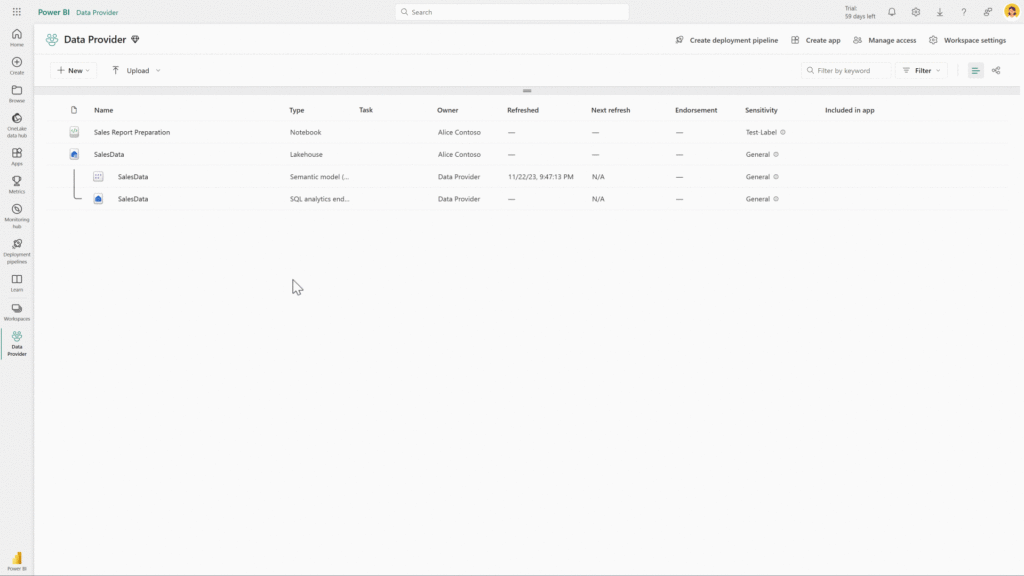
Announcements from the Microsoft Fabric Community Conference
I’m thrilled so many of you could attend the Microsoft Fabric Community Conference this week in Las Vegas, Nevada. With more than 130 sessions from experts around the world, attendees are getting hands-on experience with everything Microsoft Fabric has to offer from data warehousing to data movement to AI, real-time analytics, and business intelligence. For those who could not attend, however, I wanted to share all the announcements from the conference for Microsoft Fabric and the rest of the Microsoft data, AI, and security products in the Microsoft Intelligent Data Platform.
The Microsoft Intelligent Data Platform is our solution to help you create a powerful, agile, and secure data and AI foundation, made simple. Microsoft Intelligent Data Platform is a suite of technologies with Microsoft Fabric at its heart that helps organizations harness the full power of their data. By natively integrating products across four workloads—AI, analytics, database, and security—organizations no longer have to bear the cost and burden of stitching together a complex set of disconnected services from multiple vendors themselves. Instead, focusing on making bold, real-time decisions and empowering teams to create and innovate without limits. Learn more about the Microsoft Intelligent Data Platform and how Microsoft Fabric fits in by reading Jessica Hawk’s blog “The Microsoft Intelligent Data Platform: unleash your data to accelerate transformation.”
Many of our customers are already taking advantage of our focus on integration to accelerate their time to insight and empower more people to make data-backed decisions. For example, One NZ, one of the largest mobile carriers in New Zealand, wanted to provide nearly 1,000 users with a real-time, tailored view of customer data to provide more tailored and timely customer service. But as Strathan Campbell, Channel Environment Technology Lead at One NZ explains, “Our increasing data volumes started leading to delayed refresh rates in what should have been real-time Power BI dashboards.” They turned to Microsoft Fabric and in particular, Fabric’s real-time analytics capabilities to provide a seamless and easy-to-manage solution.
“What drew us to [Fabric] was that it was an all-in-one solution. Since we didn’t need to buy new components and were already embedded with Power BI, putting the architecture and security in place was quick and easy. Most dashboards are updated every 10 seconds now, which is six times faster than before.”
—Steven Easton, BI Channels Specialist at One NZ
Learn more about One NZ’s journey.

Join the thriving Microsoft Fabric community
It’s been fantastic meeting so many of our most active community members at the Microsoft Fabric Community Conference this week. We launched Microsoft Fabric 10 months ago at Microsoft Build—a reimagining of analytics with a single, SaaS platform that could tackle every step of the analytics process, all on a multi-cloud data lake foundation. We were thrilled by the excitement across the millions of active Power BI, Data Factory, and Synapse community members who came together to answer thousands of questions, post ideas, join user groups, and help each other along their data journeys. Your feedback has helped us create and refine so much of what makes Microsoft Fabric great. Thank you all for your ideas and constant support.
We have created new resources to help you ramp up on Microsoft Fabric and advance your career. First, visit the new Fabric Career Hub, to access a comprehensive learning journey with free on-demand and live training, discounts on certification exams, career insights from community experts, and role guidance to understand how Fabric can open potential opportunities. You can also join the vibrant Fabric Community today and engage with a huge community of data professionals to get help when you’re stuck, learn from peers, showcase your work, and even suggest product improvements.
We’ve also published an enhanced portfolio of Microsoft Credentials, including the new “Microsoft Certified: Fabric Analytics Engineer Associate” certification, along with several new Microsoft Applied Skills covering scenarios using Microsoft Fabric, like implementing lakehouses, data warehouses, real-time analytics and data science solutions—with more coming out over the next few months. Check them all out on the Microsoft Credentials homepage.
New capabilities coming to Microsoft Fabric
We have been working tirelessly over the past year to create the richest and most intuitive analytics platform on the market. We are thrilled to share the latest in a long line of innovation that is helping us fulfill the four core promises of Fabric:
- Fabric is a complete platform
- Fabric is lake-centric and open
- Fabric can empower every business user
- Fabric is AI powered
Fabric is a complete platform
Our first promise is that Fabric is a complete analytics platform with every tool your data scientists, data engineers, data warehousing professionals, analysts, and business users need to unlock value from data in a single unified SaaS platform. It also has the end-to-end, industry-leading security, governance, and data management capabilities needed to protect and manage your data. Let‘s take a look at the latest enhancements to the Fabric platform:
Over the past few months, we have made significant updates to our platform to help you tackle projects of any scale and complexity. First, we are transforming Microsoft Fabric’s CI/CD experience. This transformation includes support for data pipelines and data warehouses in Fabric Git integration and deployment pipelines. Spark job definition and Spark environment will become available in Git integration. We are also giving you the ability to easily branch out a workspace integrated into Git with just a couple of clicks to help you reduce the time to code. Additionally, because many organizations already have robust CI/CD processes established in tools such as Azure DevOps, we will also support both Fabric Git integration APIs as well as Fabric deployment pipelines APIs, enabling you to integrate Fabric into these familiar CI/CD tools. All of these updates will be launched in a preview experience in early April.
Second, we are significantly updating our dataflows and data pipeline experience in Fabric to help customers more quickly ingest and transform their data. With Fast Copy in Dataflows Gen2, you can ingest a large amount of data using the same data movement backend as the “copy” activity in data pipelines. For data pipelines, you can now access on-premises data using the on-premises Data Gateway—the same gateway used with dataflows. We are also excited to add a new activity, semantic model refresh, that enables you to use Data Factory to orchestrate the refresh of semantic models in Microsoft Fabric. Finally, we are doubling the number of activities supported in a data pipeline from forty to eighty. All of these updates are now in preview and you can try them today.
We have also listened to your feedback over the past few months and added some highly requested features to make working in Fabric even easier. We’ve released the ability to create folders in your workspaces, now in preview, and we are announcing the ability to create multiple apps in the same workspace, coming soon. We are also excited to share a feature coming soon that will give you the ability to add tags to Fabric items and manage them for enhanced compliance, discoverability, and reuse. Finally, we want to show you a sneak peek of a new feature we are bringing to Microsoft Fabric called task flows. Task flows can help you visualize a data project from end-to-end:

Security in Microsoft Fabric
With all your data flowing into the same platform, you need to be certain that data is secure at every step of the analytics journey. With that in mind, we have released a number of enterprise security features that can better protect your data. We recently announced the preview of Azure Private Link support for Microsoft Fabric which can provide secure access to your sensitive data in Microsoft Fabric by providing network isolation and applying required controls on your inbound network traffic. We also announced the preview of Trusted Workspace Access and Managed Private Endpoints which allow secure connections from Microsoft Fabric to data sources that are behind a firewall or not accessible from the public internet. Similarly, we released VNET data gateway into general availability in February which lets you connect your Azure and other data services to Microsoft Fabric and the Power Platform while ensuring no traffic is exposed to a public endpoint. We are thrilled to announce the expansion of these VNET data gateway to include on-premise data behind a VNET—now generally available.
We are also announcing deeper integration with Microsoft Purview’s industry-leading data security and compliance offerings to help you seamlessly secure data across your data estate. First, we are excited to announce that security admins will soon be able to define Purview Information Protection policies in Microsoft Fabric to automatically enforce access permissions to sensitive information in Fabric. Also coming soon is the extension of Purview Data Loss Prevention (DLP) policies to Fabric, enabling security teams to automatically identify the upload of sensitive information to Fabric and trigger automatic risk remediation actions. The DLP policies will initially work with Fabric Lakehouses with support for other Fabric workloads to follow. Finally, we are thrilled to announce the upcoming integration with Purview Insider Risk Management which will help you detect, investigate, and act on malicious and inadvertent data oversharing activities in your organization. Learn more about all of these upcoming integrations in the latest Microsoft Purview blog.
Governing data in Microsoft Fabric
With the massive growth in the volume of data, organizations are increasingly moving towards federated governance models where data is governed and managed according to the line of business needs. That is why, when we launched Fabric, we included the ability to create domains which allow tenant admins to delegate control to the domain level, enabling each business department to define its own rules and restrictions according to its specific business need. We have listened to your requests and have added, in preview, the ability for organizations to create subdomains to further refine the way your Fabric data estate is structured. Moreover, we are making it easier to create and manage domains with the ability to set default domains for security groups, the ability to use public admin APIs, and more. Learn more here.

Microsoft Purview
Secure and govern your entire data estateTo complement and extend the built-in data governance capability within Microsoft Fabric, we also natively integrate with the Microsoft Purview Data Governance solution. Today, Microsoft is announcing a reimagined data governance experience that offers sophisticated yet simple business-friendly interaction for your multi-cloud, multi-source data estate governance practice. Informed by Microsoft’s own internal journey, this reimagined experience is purpose-built for federated data governance that offers efficient data curation, data quality, and data management backed by actionable insights that help you activate and nurture your governance practice. Microsoft Fabric’s built-in governance, like item inventory, data lineage and metadata are reflected in Purview to accelerate your multi-cloud data estate governance practice. Learn more about the new Microsoft Purview experience by reading the latest blog.
Fabric is lake-centric and open
Our second promise was to design Fabric to be lake-centric and open to help you establish a trusted data foundation for your entire data estate. With OneLake, you can connect data from anywhere into a single, multi-cloud data lake for the entire organization, and work from the same copy of data across analytics engines. Two key features in OneLake, Shortcuts, and Mirroring, simplify how you bring data into OneLake.
Shortcuts enable your data teams to virtualize data in OneLake without moving or duplicating the data. We are thrilled to release the preview of shortcuts to the Google Cloud Platform. We are also announcing the ability to create shortcuts to cloud-based S3 compatible data sources, in preview, and on-premise S3 compatible data sources, coming soon. These sources include Cloudflare, Qumulo, MinIO, Dell ECS, and many more.
Last November, we shared a new, zero-ETL way of accessing and ingesting data seamlessly in near-real time from any database or data warehouse into the Data Warehousing experience in Fabric called Mirroring. We are thrilled to announce that Mirroring is now in preview, enabling Azure Cosmos Database, Azure SQL Database, and other database customers to mirror their data in OneLake and unlock all the capabilities of Fabric Data Warehouse, Direct Lake mode, notebooks, and much more. We are also offering a free terabyte of Mirroring storage for replicas for every capacity unit (CU) you have purchased and provisioned. For example, if you purchase F64, you will get sixty-four free terabytes worth of storage for your mirrored replicas. Learn more about these announcements by reading this blog.
Finally, we are introducing an external data-sharing experience for Microsoft Fabric data and artifacts, helping make collaboration easier and more fruitful across organizations. Fabric external data sharing, coming soon, enables you to share data and assets with external organizations such as business partners, customers, and vendors in an easy, quick, and secure manner. Because this experience is built on top of OneLake’s shortcut capabilities, you can share data in place from OneLake storage locations without copying the data. External users can access it in their Fabric tenant, combine it with their data, and work with it across any Fabric experience and engine.

Fabric can empower every business user
The third promise we made was to empower every business user with approachable tools in Fabric to help turn data and insights into better decisions and more innovation. Power BI has been on the leading edge of helping every user access, explore, and take advantage of data with an intuitive interface and deep integration into the apps people use every day.
As part of our commitment to empowering every user, we are adding enhancements to the core Power BI visuals including more layout options for the matrix visual, additional formatting options for all cartesian charts, and new visual types like the button slicer and the new 100% stacked line area chart.
We are also introducing a metrics layer, in Fabric, coming soon, which allows organizations to create standardized business metrics, that are rooted in measures and are discoverable and intended for reuse. Trusted creators can select Power BI measures to promote to metrics and even, include descriptions, dimensions, and other metadata to help users better understand how they should be applied and interpreted. When looking through the metrics, users can preview and explore the simplified semantic model in a simple UI before using it in their solution. These metrics can not only be used in reports, scorecards, and Power BI solutions but also in other artifacts across Fabric, such as data science notebooks.
We are also making it easier to connect to your data no matter where you are working. Later in the year, we will release the ability to live edit Direct Lake semantic models in the Fabric service right from Power BI Desktop, so you can work with data directly from OneLake. We are also enabling you to connect to over a hundred data sources and create paginated reports right from the Power BI Report Builder, now in preview. Also in preview is the new ability to create Power BI reports in the Fabric web service by simply connecting to your Excel and CSV files with relationship detection enabled. And to save you time when you are building reports, we have created new visuals for calculations we are introducing a new way for you to create and edit a custom date table without writing any Data Analysis Expressions (DAX) formulas, both in preview. Finally, you can generate mobile-optimized layouts for any report page, in preview, to help everyone view insights even on the go.
Fabric is AI-powered
Our fourth and final promise was to infuse generative AI capabilities into every layer of Fabric to help data teams accelerate their projects and focus on higher-value activities. With Copilot in Fabric, we are realizing that promise. The experiences currently in preview are already helping professionals go from raw data to insights in minutes.
I am excited to share two important updates coming to Copilot in Fabric. In November, we announced a new feature called Explore that can help users learn more about their semantic model without building a report. We also announced another new feature called the DAX query view that helps you analyze and build your semantic model by running DAX queries. I’m excited to share we are making both of these capabilities even more powerful with Copilot. In Explore, we’ve added a new “Data overview” button which provides a summary, powered by Copilot, of the semantic model to help users get started. This feature will be released in preview in early April and will roll out to regions gradually. We are also adding the ability for Copilot to help you write and explain DAX queries in the DAX query view—now in preview.
Finally, we wanted to share a sneak peek of a new generative AI feature in Fabric that will enable custom Q&A experiences for your data. You can simply select the data source in Fabric you want to explore and immediately start asking questions about your data—even without any configuration. When answering questions, the generative AI experience will show the query it generated to find the answer and you can enhance the Q&A experience by adding more tables, setting additional context, and configuring settings. Data professionals can use this experience to learn more about their data or it could even be embedded into apps for business users to query.
Join us at Microsoft Build
These announcements represent just the start of the innovation we are bringing to the Microsoft Fabric platform.
Join us at Microsoft Build from May 21st-23rd, 2024 either in person in Seattle, Washington, or online. You will hear and see our biggest announcements across the Microsoft Intelligent Data Platform and the rest of Microsoft.
Explore additional resources for Microsoft Fabric
If you want to learn more about Microsoft Fabric, consider:
- Sign up for the Microsoft Fabric free trial.
- Visit the Microsoft Fabric website.
- Join the Fabric community.
- Read the Microsoft Fabric March 2024 Update blog and other in-depth, technical blogs on the Microsoft Fabric Updates Blog.
- Explore the Fabric technical documentation.
- Learn more about Azure Innovate, our new offering to help you adopt AI.
- Join the Fabric Partner Community on Teams to stay engaged with the Fabric partner and product teams and attend weekly Fabric Engineering Connection calls every Wednesday at 8 am PDT.
- Check out the Fabric featured partners that have recent experience with deploying customer solutions on Fabric.




